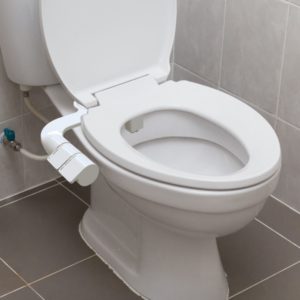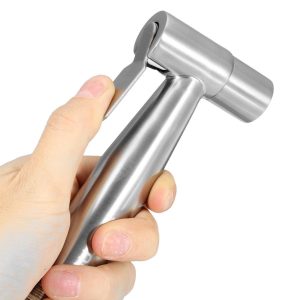Bathroom Bidet
3 DAY MAY SUPER SALE … Don’t Miss Out
A bidet (pronounced buh-day) is a basin used for cleaning yourself after using the bathroom. Bidets are common in Europe, Asia, and South America, so if you’ve ever traveled internationally, you’ve probably seen one.
If you’ve ever wondered about the proper way to use a bidet, now is a great time to learn, as they’re becoming increasingly popular..
Types of bidets
Bidets come in more forms than ever, which is part of why they’re becoming more popular. With various bidet models in demand in modern bathrooms everywhere, you can never really predict where you might encounter a handheld or built-in bidet.
Travel Bidet
The travel bidet fits conveniently in your briefcase, purse, suitcase or glove box for an instant bidet wash anywhere, anytime. The discreet carrying bag and easy-store nozzle make it a perfect solution for every travel situation. Simply fill with cool or warm water, screw on the cap, point the ergonomic nozzle in the correct direction, and press the button to get a cleansing posterior or feminine bidet wash when you need it. Take it with you on vacation, to work or whenever you leave home. A travel bidet allows you to stay clean – wherever you go.
Non-Electric Bidet Attachment
When in use, the toilet bidet attachment for toilet has a control dial which allows for adjustable water pressure, making it not only an absolutely pleasant experience but also an ideal addition to the life of anyone with mobility restrictions. All that is needed is for you to choose your ideal water pressure and cleaning mode.
Freestanding bidet
This is the traditional type of bidet. Freestanding bidets are placed next to the regular toilet, and they look like a large, low sink. Freestanding bidets are sometimes filled with water that rises to the surface of the bowl, and they may be equipped with jets.
Handheld bidet
A handheld bidet, also called a bidet shower or bidet sprayer, is a nozzle that stays attached to the toilet. This type of bidet is manually placed near your private area to clean your genitals and anus after using the toilet, sexual intercourse, or for freshening up. With a handheld bidet, you control the positioning of the stream of water.
Built-in bidet
A built-in bidet is a toilet equipped with a bidet feature. After flushing a toilet with a built-in bidet, the toilet may automatically dispense a vertical stream of water to cleanse you.
Warm water bidet
A warm water bidet can be built-in, free-standing, or a sprayer attachment. A warm water bidet is simply hooked up to the hot water pipe system or has a built-in water warmer which provides a warmer spritz to your bottom when you use it.
How to use a bidet
If you see a bidet “out in the wild,” make a plan for how you’re going to use it before you make an attempt. Try turning the spray nozzle on or flushing the built-in bidet, so you can see where the stream of water will come from and how powerful the water pressure will be.
Tips for use
Check out the bidet before you try to use it. Figure out where the jets of water are going to come from so you’re prepared.
When you first use a bidet, clean off with toilet paper first before attempting the bidet spray.
You don’t need to use soap to use a bidet. Some people do use the bidet like a mini-shower after a bowel movement, sexual intercourse, or for freshening up, but it isn’t a requirement.
Make sure that any clothing items (like underwear, pants, and tunic-style shirts) are out of the way before turning on the bidet jets.
You may notice a towel hanging within arm’s reach of your bidet. Be forewarned that this is for drying off your hands, never your rear.
For best results with a bidet attachment, make sure you remember to shut off the T-valve after every use, with no exceptions. Forgetting to turn it off could result in a leaky attachment.
If you have a vulva, be sure to direct the water front-to-back to avoid getting bacteria into your vulva.
Cautions
Bidets can be a great alternative to toilet paper, but that doesn’t mean that there are no drawbacks or risks associated with using them. Bidets are decidedly not for everyone, and if you have a weakened immune system, you might want to wait a bit before trying one out.
If you have male genitalia, using a bidet before having a bowel movement could result in an itchy feeling on your anus. A 2016 studyTrusted Source in Japan strongly linked using the bidet prior to elimination as opposed to just using it afterward to symptoms of itching.
If you have female genitalia, using bidets may increase your risk of bacterial vaginitis. At least one studyTrusted Source has demonstrated that using a warm water bidet aggravates the natural balance of flora in the vagina.
Electric warm water bidets also carry a general risk of bacterial contamination, according to a 2017 studyTrusted Source done in hospitals.
The bottom line
Bidets may take some getting used to, but many people like them so much that they decide to make a permanent switch.
If you want to try using a bidet, take a good look around at the equipment and make sure you’re prepared for the jets.
People with conditions such as hemorrhoids or irritable bowel syndrome (IBS) might benefit from giving the bidet a try.



